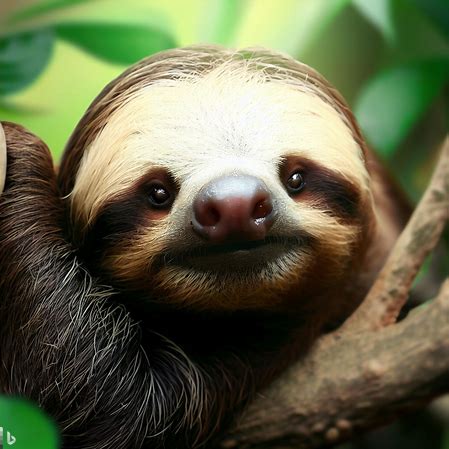
Sloths – those fascinating creatures that hang gracefully from tree branches – have intrigued researchers and nature lovers alike. Are they mammals? Yes! They are warm-blooded, possess mammary glands and fur.
Sloths are part of the Pilosa order and the Folivora suborder, meaning they mostly eat foliage. They never leave their trees, using their strong claws to climb. There are two species of sloths: two-toed and three-toed. Their main difference is the number of toes.
Unique sloth adaptations include amazing swimming abilities, and a low-energy lifestyle enabled by their slow metabolism and leafy diet. Also, they help balance ecosystems by spreading seeds with their feces. So when you see one hanging from a tree branch, appreciate these amazing mammals!
Definition of Mammals
Do sloths count as mammals? To answer this, we must look at what defines mammals. Mammals have mammary glands for nursing their young with milk. They also have fur or hair to regulate their body temperature. Plus, all mammals give live birth – except for monotremes like platypuses, which lay eggs!
Sloths fit the mammal bill – they have mammary glands and fur. Also, they give birth to their babies alive. So, we can say with confidence that sloths are mammals!
Pro Tip: When studying animal classifications, don’t just look at how they look. Instead, focus on the traits that define each group. That way, we can accurately classify animals like sloths as mammals – based on science, not assumptions!
Sloths may move slowly, but they’re still mammals. And they get a pass for being late because of it!
Characteristics of Sloths

Sloths have one-of-a-kind traits that set them apart. These special qualities make them a captivating species in the animal kingdom.
Firstly, sloths boast an extraordinarily sluggish metabolic rate. This means low energy usage and a slow pace. This sluggishness helps them to store energy and adapt to their environment.
Secondly, sloths have long, curved claws. These specialized claws provide them with a secure hold and make it easier for them to explore their arboreal habitat.
Thirdly, sloths have an extraordinary digestive system. They have several stomach compartments which help break down their mainly vegetarian diet. Unlike most mammals, they can digest hard-to-process leaves.
On top of that, their fur offers excellent camouflage. The algae on their fur lets them blend in with the green foliage of the trees they live in, providing ideal protection from predators.
Also, sloths have specialized neck structures that let them rotate their heads up to 270 degrees. This allows them to have a wider view and detect potential danger or food quicker.
In addition, sloths are skilled swimmers, despite their slow movement on land. They can hold their breath for up to forty minutes and paddle through water using their strong arms.
Moreover, sloths spend much of their time hanging upside down from tree branches. This behavior is a result of their physical adaptations and serves both as protection and a way to save energy.
To guarantee sloths’ well-being in captivity or during conservation efforts, a few measures can be taken. One involves providing an appropriate environment with enough vertical space for them to climb and hang, which replicates their natural environment.
Other suggestions include offering a diet abundant in plant-based foods such as fruits and vegetables, since this is what they usually eat. Moreover, regular veterinary check-ups are important to assess their health and address any problems swiftly.
Finally, keeping disturbances in their habitat at a minimum helps minimize their stress. Sloths are delicate creatures, and a tranquil atmosphere allows them to thrive.
By following these suggestions, we can make sure that sloths get the care they need while maintaining the unique characteristics that make them so amazing.
Classification of Sloths as Mammals

Sloths are mammals! They belong to the Mammalia class, which includes animals with mammary glands and fur/hair. Other mammal traits include regulating body temperature, live birth, and feeding young with milk. Sloths have: mammary glands, fur, warm-bloodedness, and live birth. Plus, they have unique traits like a slow metabolism and long claws for gripping branches. To understand these mammals, don’t overlook their adaptations. Explore the wonders of mammals! Sloths have mastered taking it slow – even in their evolution.
Evolutionary History of Sloths
The evolutionary tale of sloths is fascinating. These creatures have adapted and survived over time in amazing ways that surprise scientists and nature lovers.
It’s believed sloths descended from ancient, giant mammals that walked the earth millions of years ago. These early relatives of sloths changed their environment, and eventually evolved into the sloths we know today.
Sloths switched from active to a more leisurely lifestyle. To survive in treetops, they developed special features like longer limbs and sharp claws. Plus, their slow metabolism helped them conserve energy.
Believe it or not, sloths share a common ancestor with anteaters and armadillos!
Searching deeper into the evolution of sloths shows us their impressive adaptations and survival strategies. It’s a testament to their resilience and cleverness.
Plus, looking at the sloth’s evolution gives us knowledge on how other species adapt. By understanding how sloths adapted to environmental changes, we can get an idea of adaptive processes in general. Sloths may be slow, but they sure know how to survive!
Common Misconceptions about Sloths
Common misunderstandings about sloths can lead to misconceptions and false beliefs. Gaining an understanding of the truth behind these myths is important for appreciating sloths.
Contrary to popular opinion, sloths have captivating traits that make them unique. These include their impressive climbing skills due to their strong limbs and claws. As well, their metabolism is extremely slow, allowing them to survive on a diet of leaves only.
Reliable sources such as the International Union for Conservation of Nature (IUCN) conduct research on animal species. This helps us understand facts about sloths. For example, sloths conserve energy by moving slowly. They are not lazy, but rather perfectly adapted to their environment. They belong to the mammal family and share traits such as giving birth to live young and producing milk for their offspring. Although they spend time hanging upside down, they can also move around on the ground. Lastly, sloths are gentle and harmless to humans. They rely on camouflage instead of aggression to protect themselves.
In conclusion, sloths show that being a mammal is not about speed – it’s about being too lazy to lay eggs!
Frequently Asked Questions
1. Are sloths mammals?
Yes, sloths are mammals. They belong to the group of mammals known as Xenarthra, which also includes armadillos and anteaters.
2. What characteristics make sloths mammals?
Sloths possess key mammalian characteristics such as giving birth to live young, producing milk to feed their offspring, having hair or fur on their bodies, and being warm-blooded.
3. Do sloths have any unique mammalian features?
Yes, sloths have several unique mammalian features. They have specialized hook-like claws to hang upside down from trees, long limbs for proficient climbing, and a slow metabolic rate, which is one of the slowest among all mammals.
4. Are sloths considered placental mammals?
Yes, sloths are considered placental mammals. They give birth to live young after a gestation period, during which the embryo develops within a placenta inside the mother’s body.
5. How many types of sloths exist?
There are two main types of sloths: two-toed sloths and three-toed sloths. They are distinguished by the number of toes they have on their front limbs.
6. Are sloths related to any other mammal species?
Sloths are distantly related to armadillos and anteaters, as they all belong to the Xenarthra order. However, they do not share a close evolutionary relationship with any other specific mammal species.
Conclusion
Sloths are mammals! They have fur, produce milk for their young, and are warm-blooded. But, there’s more to know about these creatures!
Their slow movements are an adaptation to their low-calorie diet of leaves. This helps them conserve energy in their rainforest home.
They are unique in their ability to hang upside down for long periods without expending much energy. Plus, they have extra neck vertebrae that let them turn their heads 270 degrees.
Sloths also have a special digestive system that takes days to process the tough cellulose in leaves. This has created a symbiotic relationship with algae and microorganisms living on their fur. The green coloration provides camouflage and nourishment.
When you see a sloth in its natural habitat, be patient and observe from a distance. They are important and deserve our respect!

